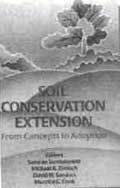The good earth
 IF AN agricultural idea finds favour with farmers, you scarcely need an extension service to ensure its spread. But if it does not find favour, then you can double the size of the extension service and it still will not work - Confucius.
IF AN agricultural idea finds favour with farmers, you scarcely need an extension service to ensure its spread. But if it does not find favour, then you can double the size of the extension service and it still will not work - Confucius.
Soil conservation efforts started more than 50 years ago, but the success of most have not been anything to write about. Strategies were more laboratory-oriented than field-oriented. Realisation of this dawned about a decade back. The change in strategy and resultant success has restored confidence in the assumption that soil can be conserved in a manner that is acceptable and sustainable.
The four components that go into the making of a successful project are concept, strategies, implementation and adoption. And adoption is the key word. Though efforts at conserving soil started half-a-century ago, success has been moderate. Technologies have not been adopted, especially in developing countries where the problems are more grave. And the reason was not new: lack of communication between technology suppliers and the users. Efforts to involve communities whose land was at stake was lacking. Unless the users' problems and perceptions are addressed, the technology is destined to be a failure. One of the best examples to illustrate this could be from India. Vetiver grass cultivation, in spite of strong peddling by the World Bank, did not impress farmers living in the Himalayan foothills. They refused to adopt contour vegetative barriers, contour cultivation and strip cropping.
In the past 50 years, soil quality has degraded irreversibly in about one-fifth of the Earth's land surface. If this continues unabated, by the year 2000, agricultural soil productivity will decrease by 15 to 30 per cent compared to its 1975 level. A global assessment from 1987-90 showed that soil degradation to be a result of agricultural activities, irrespective of the technique involved. Soil erosion by water and air account for 56 per cent and 28 per cent of global erosion respectively.
Degraded soil takes time to recover and despite conservation efforts, erosion rates are still high. In the US, for instance, the average annual erosion rate is around 18 tonnes per hectare (ha). And in the highlands of Ethiopia, the average annual soil loss rate is about 48 tonnes per ha. This is 1O-30 times the estimated soil formation rates in these areas. In the US, 50 per cent of the fertiliser used is needed to compensate for the loss in natural topsoil fertility.
Based on a 1995 workshop on soil conservation extension, the book under review provides an in-depth overview on what is being done to conserve soil in different parts of the world, and the problems that are being encountered.
The section on concepts describes soil conservation attempts by various communities and how indigenous knowledge can be incorporated in watershed development programmes. It also highlights the importance of decision-making authorities and the role of third-party facilitators, such as the non-governmental organisations.
In the past, conservation programmes attempted to slow down erosion by constructing physical barriers. However, it did little to even maintain soil productivity. Current strategies aim at improving soil condition and soil cover. Strategies are now based on better land husbandry, assuming that farmers can better manage and improve their land resources given conducive conditions and assistance.
To be effective, implementation has to be site specific. The people involved alone can bring about desired changes quickly and extensively. These programmes are effective only if there is large-scale participation, and possible only if tangible benefits are assured. The section on implementation describes the application of programmes in east Africa, India and Bangladesh among others.
But the acid test of any soil conservation programme is its adoption. Adoption involves decision-making, where individuals or communities evaluate and accept an innovation. For adoption of a programme, technical, economic and socio-cultural aspect of the targeted community needs to be addressed.
As early as 500 BC, Confucius described the fate of various agricultural technologies and the reasons behind their failures: please the farmer, and he will please Mother Earth.
Related Content
- Order of the National Green Tribunal regarding solid and liquid waste management in Sikkim, 16/01/2025
- No time to lose, says Sunita Narain on the new IPCC report
- Climate Change could burgeon into Covid-19 like crisis, warn most urban Indians: Ipsos Earth Day 2020 Global Survey
- Forest cover in NE states: Parliamentary panel asks environment ministry to arrest declining trend
- ‘Solar alliance must be agile, results-oriented’
- When earth gives back as good as it gets
